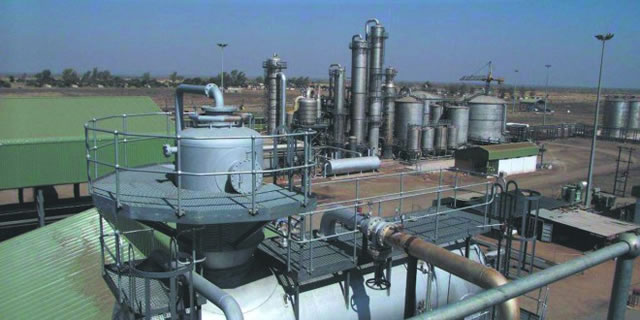Sweet project, green coffers


Chisumbanje Ethanol Plant
Mabasa Sasa Deputy Editor
Just last year, it looked as if the massive Chisumbanje Ethanol Plant in eastern Zimbabwe would turn into the clichéd white elephant. And not just any other white elephant: a US$600 million white elephant.That was after the plant shut down because there were no takers for the ethanol. The plant can store up to 10 million litres of ethanol.
But political bickering between parties who were supposed to be partners in a coalition government saw to it that the produce from the plant did not find its way onto the market.
After the July 31, 2013 elections decisively won by Zanu-PF, the plant is really back in business. Recently, President Mugabe’s government instituted a mandatory ethanol blending ratio for petrol of 10 percent, and this will rise to 20 percent over the next year.
With the country using 1,5 million litres of petrol daily, this means the Chisumbanje plant will initially put 150 000 litres of ethanol on the market every day. The plant can produce more than 350 000 litres per day.
By 2020, the plant will churn out 500 million litres of ethanol annually, which will be enough to completely substitute all petrol imports. Zimbabwe can save up to US$2m in imports daily through ethanol.
The benefits are obvious: use of ethanol will slash the fuel import bill, create jobs, add value to local industry, and reduce harmful carbon emissions.
Now, several countries in Southern Africa are interested in buying ethanol from Chisumbanje. It is understood that Botswana, Malawi, Mozambique, South Africa and Zambia have initiated contacts regarding this matter.
Green Fuel, which runs Chisumbanje Ethanol Plant (is a joint venture between the state-owned Agricultural Rural Development Authority, Macdom Investments and Rating) has said they are prepared to supply Sadc with its environmentally friendly produce.
The GM at Green Fuel, Graham Smith, said: “We have been approached by Zambia, Malawi, Mozambique, Botswana and South Africa, which have introduced blending of petrol to ethanol at varying levels.”
There is a fear that ethanol might not be compatible with the engines in use today — a concern that experts say is not sufficient to jettison blending. Placing a flex fuel conversion kit link on the engine to enhance oxygen intake into the pistons is all that’s required to make an ordinary petrol vehicle run on 95 percent ethanol.
The flexi link costs about US$40 in Zimbabwe. Environmentalists also point out that the carbon produced from burning ethanol is recaptured by the sugar cane in the fields.
Further, ethanol production has by-products such as animal feeds and electricity. The Chisumbanje plant generates 7MW. It uses 2MW and sells the other 5MW to independent buyers or the national grid.
Global Trend
Use of ethanol blend is in line with a growing global trend to not only cut down on import bills, but also to increasingly use environmentally friendly fuels.
Countries like India, Thailand, Latin America, the US, several in Europe and Australia have a minimum blending requirement of five percent.
In most parts of the world, lead additives in petrol have been eliminated. Africa, to a large extent, remains the exception. It is in this context that investment in ethanol production becomes critical.
Chisumbanje Ethanol Plant is the single biggest infrastructure investment Zimbabwe has seen since the construction of Kariba Dam in the 1950s under the Federation of Rhodesia and Nyasaland.
It has been rated by Africa Investor magazine as one of the continent’s 100 largest infrastructure development programmes. (Five Zimbabwean projects are in the top 100.)
The magazine classifies mega projects as those with a budget of more than US$1m, take more than five years to complete, affect the lives of more than a million people, and have far reaching economic implications — often beyond the borders of the countries in which they are implemented.
The Chisumbanje project covers 120 000 hectares of land, most of which is under sugar cane for the ethanol plant. By switching to even a minimum of five percent ethanol blend, Sadc countries could save hundreds of millions yearly and also cut down on harmful tailpipe emissions.
Investment in such infrastructure projects will result in greater regional integration and development. By any measure, this is a sweet deal.
According to the Cane Resources Network for Southern Africa, investment in ethanol is a win-win. In a report titled “Bio-energy for Sustainable Development and Global Competitiveness: the case of sugar cane in Southern Africa”, the network’s researchers say the time is perfect for going green.
“Like the rest of the world, the sugar industry in Southern Africa has faced increasing competitive pressures in recent years due to factors such as saturated demand in industrialised countries and competition from other sweeteners, which has resulted in low and/or fluctuating sugar prices.
“These difficulties have increased economic incentives for sugar producers to diversify their product portfolio by investing in renewable energy applications.” Sadc produces more than five million tonnes of sugar yearly (3,5 percent of global production) but around 40 percent of if goes to the EU and the US.
This is largely due to the existence of export quotas, but also indicates a lack of appreciation of how sweet sugar could be a major export to regional economies.
Apart from the most obvious benefits, investment in sugar would greatly boost the standards of living of small-scale farmers. The Cane Resources Network for Southern Africa says, “Smallholder participation in the sugar industry has been encouraged in some countries, but the contribution of the sector in terms of cane production is often small.
“Smallholders account for around 25 percent of cane production in Mauritius, 20 percent in Zambia and 15 percent in South Africa. In Malawi, Swaziland, Zimbabwe, and Mozambique, smallholders typically account for less than five percent of cane output.
“In South Africa, the industry is responding to the government’s target of 30 percent black freehold agriculture land ownership by 2015. This translates into the transfer of 78 000ha of privately owned land in addition to the 18 000ha transferred back into black ownership over the past decade.
“Sadc countries that are able to expand (primarily lower cost centres), will have the opportunity to offer greater smallholder participation.” — Southern Times.








Comments